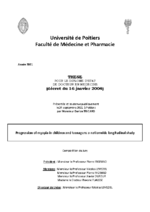Thèse d'exercice
Tricard Dorian
Progression of myopia in children and teenagers: a nationwide longitudinal study
AnglaisConsulter le texte intégral (format PDF)

Résumé
Français
- Troubles de la vision -- Facteurs de risque
- Myopie -- Chez l'enfant
- Myopie -- Chez l'adolescent
- Myopie -- Épidémiologie -- France
English
Progression of myopia in children and teenagers: a nationwide longitudinal study
BACKGROUND
Data on myopia prevalence and progression in European children are sparse. The aim of this work was to evaluate the progression of myopia in children and teenagers in a large prospective study.
METHODS
A prospective study involving a nationwide cohort. Myopia was defined as a spherical equivalent of less than or equal to –0.50 diopters. Data on refractive error, gender and age were collected during seven consecutive years. Data were collected in 696 optical centers in France between 2013 and 2019, including 136,333 children (4–17 years old) in the analysis.
Progression of myopia was assessed between the first visit and the last visit over up to 6.5 years.
RESULTS
Mean age was 11.3 ± 3.8 years (55.0% of female). The proportion of children progressing more than –0.50 D per year was higher in age groups 7–9 years and 10–12 years and in children with SE ≤ –4.00 D at first visit, representing 33.1 %, 29.4 % and 30.0% of these groups, respectively. In multivariate analysis, progression during the first 11 to 24 months was higher in the 7 to 9 and 10 to 12 age groups (–0.43 D and –0.42 D respectively), for higher spherical equivalent at baseline (at least –0.33 D for SE ≤ –1 D) and for girls (–0.35 D).
CONCLUSION
This is the first French epidemiological study to investigate myopia progression in a large cohort of children. Sex, age groups and myopia severity are associated with differing rates of progression.
Keywords : myopia, myopia progression, pediatric cohort, pathologic myopia, risk factors.
Notice
- Diplôme :
- Diplôme d'état de médecine
- Établissement de soutenance :
- Université de Poitiers
- UFR, institut ou école :
- Domaine de recherche :
- Médecine. Ophtalmologie
- Directeur(s) du travail :
- Nicolas Leveziel
- Date de soutenance :
- 24 septembre 2021
- Président du jury :
- Pierre Ingrand
- Membres du jury :
- Nicolas Leveziel, Pierre Ingrand, Xavier Dufour, Roxane Flausse
Menu :
-
-
à propos d'UPétille
-
Voir aussi
Annexe :

-
Une question ?
Avec le service Ubib.fr, posez votre question par chat à un bibliothécaire dans la fenêtre ci-dessous ou par messagerie électronique 7j/7 - 24h/24h, une réponse vous sera adressée sous 48h.
Accédez au formulaire...
Université de Poitiers - 15, rue de l'Hôtel Dieu - 86034 POITIERS Cedex - France - Tél : (33) (0)5 49 45 30 00 - Fax : (33) (0)5 49 45 30 50
petille@support.univ-poitiers.fr -
Crédits et mentions légales
